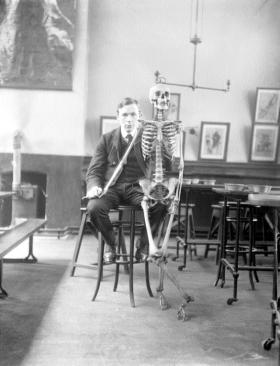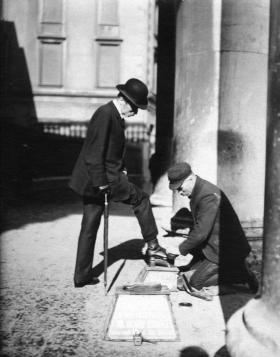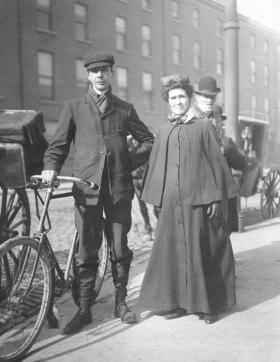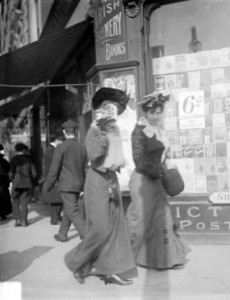Dubliners—an exhibition of photographs by J.J. Clarke
Published in 20th-century / Contemporary History, Features, Issue 2 (Summer 2004), Reviews, Volume 12National Photographic Archive, Meeting House Square, Temple Bar, Dublin, until 29 May 2004.
by Tony Canavan
 Today, when many exhibitions present a multimedia, interactive experience, this one stands out for its simplicity. It is a straightforward display on two floors of the National Photographic Archive of the black-and-white photographs of Dr J.J. Clarke from circa 1900 with captions and nothing else. The photographs speak for themselves and the visitor is left to relate to the people they portray in a fundamental, human way. The purpose-built gallery is well designed to show off this collection to good effect, and the visitor can proceed at his or her own pace, moving swiftly on from one photograph to another or stopping to ponder each in detail.
Today, when many exhibitions present a multimedia, interactive experience, this one stands out for its simplicity. It is a straightforward display on two floors of the National Photographic Archive of the black-and-white photographs of Dr J.J. Clarke from circa 1900 with captions and nothing else. The photographs speak for themselves and the visitor is left to relate to the people they portray in a fundamental, human way. The purpose-built gallery is well designed to show off this collection to good effect, and the visitor can proceed at his or her own pace, moving swiftly on from one photograph to another or stopping to ponder each in detail.
The exhibition was first shown in 2001 and is back by popular demand to coincide with the Ulysses centenary, and it is eminently appropriate for that as it captures the faces of the Dublin in which James Joyce’s novel is set. In 1897 J.J. Clarke left Castleblaney, Co. Monaghan, to study medicine at the Royal University, Earlsfort Terrace, Dublin (pictured below left). He was a keen amateur photographer and the pictures here were all taken between 1897 and 1904. What is most remarkable for the time is his almost journalistic eye for catching people in candid shots rather than photographing formal poses or streetscapes. He died unmarried at the age of 82, and 300 original prints or glass negatives survived to be donated to the archive by his nephew, Brian Clarke.
 The photographs are arranged roughly in themes, either of location, such as Grafton Street, or subject, like transport. Each is accompanied by a caption with a brief description of the subject and, occasionally, historical information. For example, a photograph of a man alongside a bike with pneumatic tyres is accompanied by a caption explaining that the air-filled tyre was ‘invented by Belfast vet, John Boyd Dunlop’, and that ‘subsequent mass production of reasonably priced bicycles allowed working men to use them for both transportation and leisure’ (top left). Some of the captions may be a little too terse for the casual visitor. For instance, one simply states ‘A couple on a horse-drawn vehicle’, ignoring the fact that the man is in servant’s livery and the lady is watching something through opera glasses, probably the parade in one of the other photographs.
The photographs are arranged roughly in themes, either of location, such as Grafton Street, or subject, like transport. Each is accompanied by a caption with a brief description of the subject and, occasionally, historical information. For example, a photograph of a man alongside a bike with pneumatic tyres is accompanied by a caption explaining that the air-filled tyre was ‘invented by Belfast vet, John Boyd Dunlop’, and that ‘subsequent mass production of reasonably priced bicycles allowed working men to use them for both transportation and leisure’ (top left). Some of the captions may be a little too terse for the casual visitor. For instance, one simply states ‘A couple on a horse-drawn vehicle’, ignoring the fact that the man is in servant’s livery and the lady is watching something through opera glasses, probably the parade in one of the other photographs.
 Women feature prominently in the collection. There are self-confident women walking into the National Library (where they were only recently allowed to join the staff), camera-shy shoppers in Grafton Street (top right), smartly dressed ladies on Bray promenade and nurses in Merrion Square. Men, of course, are well represented: dapper dandies, ‘gents’ in top hats and frock coats, poorly dressed shoe-shiners (opposite page), cabbies and policemen. Children too are shown in various types of prams or playing on the beach, for example. Among the more unusual is a ‘genuine’ American Indian advertising a show in the Queen’s Royal Theatre, Pearse Street.
Women feature prominently in the collection. There are self-confident women walking into the National Library (where they were only recently allowed to join the staff), camera-shy shoppers in Grafton Street (top right), smartly dressed ladies on Bray promenade and nurses in Merrion Square. Men, of course, are well represented: dapper dandies, ‘gents’ in top hats and frock coats, poorly dressed shoe-shiners (opposite page), cabbies and policemen. Children too are shown in various types of prams or playing on the beach, for example. Among the more unusual is a ‘genuine’ American Indian advertising a show in the Queen’s Royal Theatre, Pearse Street.
While in the main the photographs were taken in and around the Grafton Street/St Stephen’s Green area, places such as Portobello, Kingstown (Dún Laoghaire today) and Bray are represented too. The photographs of Bray—dubbed ‘the Brighton of Ireland’—are particularly interesting, showing among other things a beach-side telescope, crowds on the promenade and horse-drawn bathing-boxes, employed to convey the modest bather into the water and still used, the caption says, in some Irish seaside resorts until the 1950s! Elsewhere a group of Russian sailors adds a flavour of the exotic to Kingstown seafront.
 What impresses most about this exhibition is the immediacy of the subjects. It was unusual at this time to take unposed photographs of people in everyday situations and it is fortunate that Dr Clarke’s collection survived. A careful study of them will tell the observer much about life and social conditions in Dublin in 1900, as well as how much the streetscape of the city centre has changed. However, the real strength of this exhibition is that in a simple but effective way it succeeds in engaging the visitor with the humanity of people who lived 100 years ago as every photograph portrays a meaningful slice of life in Joyce’s Dublin. It is a clear example of how very often the best exhibitions consist of items being allowed to speak for themselves without the need for audio-visual pyrotechnics or hi-tech interactive devices.
What impresses most about this exhibition is the immediacy of the subjects. It was unusual at this time to take unposed photographs of people in everyday situations and it is fortunate that Dr Clarke’s collection survived. A careful study of them will tell the observer much about life and social conditions in Dublin in 1900, as well as how much the streetscape of the city centre has changed. However, the real strength of this exhibition is that in a simple but effective way it succeeds in engaging the visitor with the humanity of people who lived 100 years ago as every photograph portrays a meaningful slice of life in Joyce’s Dublin. It is a clear example of how very often the best exhibitions consist of items being allowed to speak for themselves without the need for audio-visual pyrotechnics or hi-tech interactive devices.
Tony Canavan is the former Museum Officer of Newry and Mourne District Council.
















